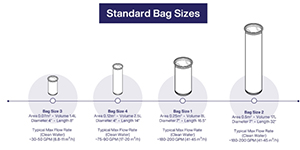
15 October 2024 | PoreFiltration
How to choose the right filter bag for your application
Selecting the correct bag filter for your application can be overwhelming due to the variety of sizes, materials, and micron ratings available.
However, understanding the core factors that influence your decision will help ensure you choose the best filter to achieve the desired performance. This guide will help you navigate these choices, particularly focusing on flow rates, suitability for different applications, and how bag sizes affect performance.Key Factors influencing Bag Filter Selection:
Flow Rate
Bag Size
Micron Rating
Material Compatibility
Operating Conditions
Application Suitability
1. Flow Rate Considerations
Each filter bag size has a corresponding maximum flow rate it can handle. To maintain efficient filtration, it is crucial to match the filter size to the expected flow rate in your system. Here are the typical flow capacities for standard bag filter sizes:
Important Considerations for Flow Rates:
- Flow rates provided are based on clean water. In real-world applications with more viscous or particulate-laden fluids, the achievable flow rates may be lower.
- Exceeding the recommended flow rate may reduce filtration efficiency, increase pressure drop, and lead to premature clogging.
The filter bag size plays a significant role in determining its capacity and suitability for specific applications:
Size 1: Ideal for smaller systems or where limited space is available. Suitable for batch processes or lower flow applications.
Size 2: Common in industrial processes, offering a larger filtration area and higher capacity. Best for continuous operations with moderate to high flow rates.
Size 3 & 4: Smaller sizes used in low-flow applications or where frequent filter changeouts are acceptable.
Size 5: Often used in specialized applications where a balance between size and capacity is needed.
3. Micron Rating
Micron ratings indicate the particle size a filter can capture. The smaller the micron rating, the finer the filtration. Standard micron ratings range from 1 to 200 microns. Selecting the right micron rating depends on your process requirements:
Coarse filtration: 50-200 microns (removing visible particles)
Medium filtration: 10-50 microns (removing fine sediment and contaminants)
Fine filtration: 1-10 microns (used in processes requiring high purity)
Note: As the micron rating decreases, pressure drop increases, potentially affecting flow rates.
4. Material Compatibility
Bag filters are available in various materials, such as:
Polypropylene: Good for general-purpose filtration and chemical resistance.
Polyester: Better for higher temperatures and broader chemical compatibility.
Nylon: Used for fine filtration or where extra strength is required.
Ensure the filter material is compatible with the liquid being filtered to avoid degradation, swelling, or chemical reactions.
5. Operating Conditions
Consider the following when selecting a bag filter:
Temperature: Ensure the filter material can withstand your operating temperature.
Pressure: Higher pressure drops may occur with finer micron ratings or higher viscosities. Use pressure gauges to monitor differential pressure and avoid filter collapse.
Fluid Type: Viscous liquids or those with high particle loads may require larger filters or more frequent changeouts.
6. Application Suitability
Different industrial applications have specific requirements for bag filters based on fluid types, contamination levels, and operational needs. Below is an overview of common industries and the typical bag filters they use:
1. Chemical Processing
Size: Commonly Size 2 for high flow rates and continuous operations.
Micron Rating: 1-50 microns, depending on the filtration stage (coarse or fine).
Material: Polypropylene, polyester, or PTFE, depending on chemical compatibility.
Use Case: Filtering aggressive chemicals, solvents, or corrosive fluids.
2. Food and Beverage
Size: Size 2 for higher volume processing, Size 1 for smaller batch operations.
Micron Rating: 1-10 microns for final filtration of beverages like wine, beer, or juice.
Material: FDA-compliant materials such as polypropylene or nylon.
Use Case: Filtering solids, sediments, and impurities from liquids like dairy, juices, and syrups.
3. Water Treatment
Size: Size 2 for municipal or industrial water treatment, Size 3 & 4 for smaller installations.
Micron Rating: 5-100 microns, depending on sediment levels.
Material: Polypropylene or polyester, depending on water quality and temperature.
Use Case: Removing sediments, algae, and particulate matter in raw water or wastewater treatment.
4. Oil and Gas
Size: Size 1 and 2 for high-flow systems in upstream or downstream processes.
Micron Rating: 10-200 microns, depending on whether filtration is for production fluids or final processing.
Material: Polyester, nylon, or custom blends for high temperatures and hydrocarbon resistance.
Use Case: Filtering particulates from drilling mud, produced water, or refinery processes.
5. Paints, Coatings, and Inks
Size: Size 2 for batch processing and continuous operations.
Micron Rating: 1-50 microns for fine filtration of pigments and solids.
Material: Nylon or polyester, for resistance to solvents and compatibility with high-viscosity fluids.
Use Case: Ensuring consistent particle size in paints and coatings to avoid defects in final products.
6. Pharmaceutical and Biotech
Size: Size 1 or 2, depending on production scale.
Micron Rating: 1-10 microns for sterile filtration and removal of fine contaminants.
Material: FDA-approved polypropylene or nylon.
Use Case: High-purity filtration for sterile processes, ingredient clarification, and removal of bacteria or fine particles.
7. Automotive
Size: Size 2 for large-scale production facilities, Size 3 for smaller systems.
Micron Rating: 5-100 microns for coolant and lubricant filtration.
Material: Polyester or polypropylene, depending on temperature and fluid compatibility.
Use Case: Filtering metal shavings, debris, and particulates from automotive fluids like coolants and lubricants.
Conclusion
Choosing the right bag filter involves understanding the flow rate, bag size, micron rating, and application requirements. By matching these factors with the appropriate material and industry-specific needs, you can optimize your filtration system for efficiency and longevity.
For specific recommendations, consult a filtration specialist who can assess your system and provide tailored advice based on your exact process needs.